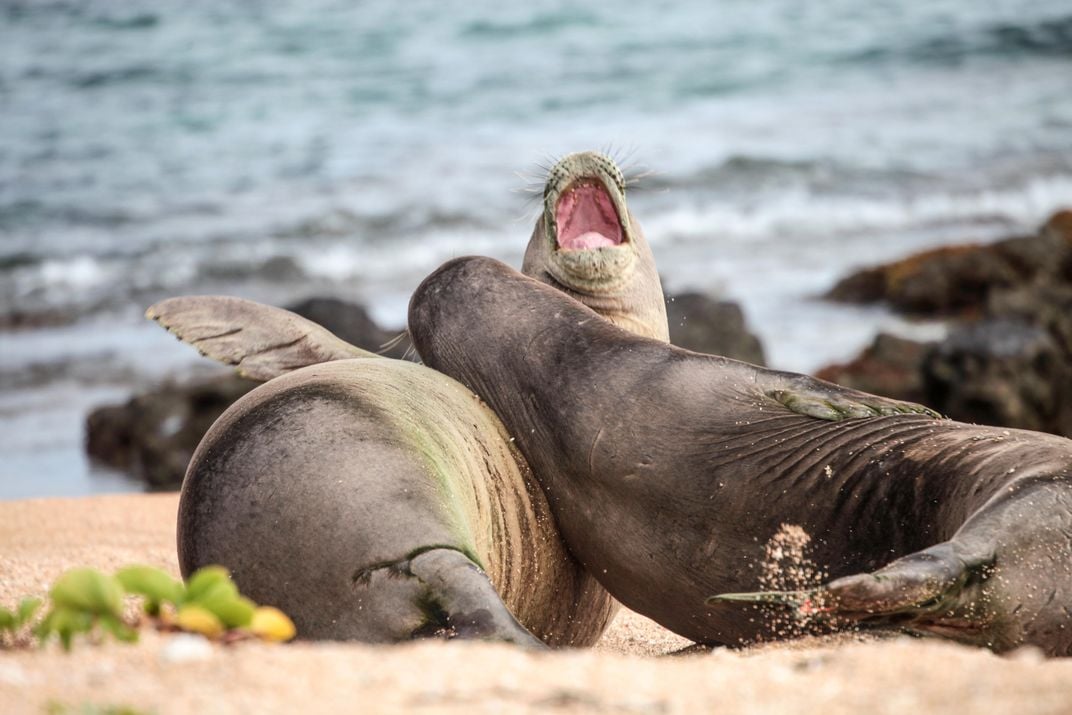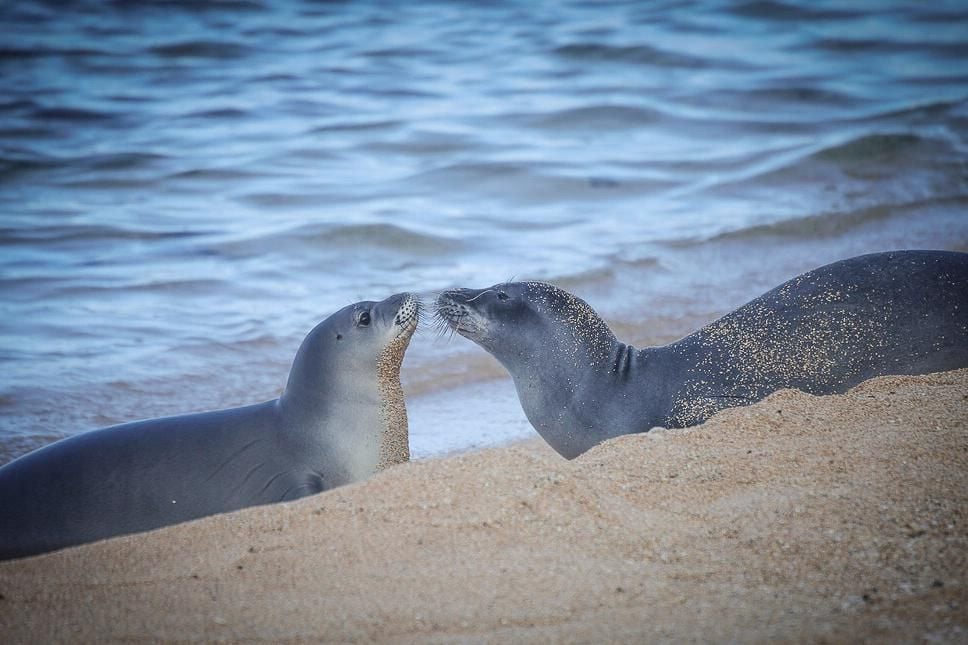Why Rare Hawaiian Monk Seals Are Lining Up to Get Their Shots
Fearing devastating disease, researchers are vaccinating a wild marine mammal for the first time
/https://tf-cmsv2-smithsonianmag-media.s3.amazonaws.com/filer/a8/8f/a88facea-dbb0-4206-9619-096b75933807/unknown.jpeg)
On a summer day on the island of Kaua`i, a Hawaiian monk seal hauls his 500-pound body out of the surf and galumphs toward a nursing female and her newborn pup. When he gets a few feet away from the mother, she arches her back and faces him, head high. He does the same. She barks. He barks. Snot and saliva fly.
It’s typical—if awkward—monk seal courtship behavior, more posturing than physical. But scientists are concerned that this kind of scene could swiftly turn into a deadly disease outbreak for one of the most endangered marine mammals in the world. The Hawaiian monk seal has been listed under the Endangered Species Act since 1976, after its numbers were devastated by decades of hunting and other forms of human contact.
About a decade ago, researchers grew worried that a strain of morbillivirus, the genus of viruses that includes measles and canine distemper, could wipe out the last of these rare seals. In response, they’ve launched the first-ever effort to vaccinate a species of wild marine mammals—an effort that has come with a host of first-ever challenges.
The 1,200 or so monk seals that survive in the wild are spread over vast swaths of ocean, coming ashore for only brief periods of time to rest, molt and give birth on islands that stretch across the Central Pacific. Morbillivirus, which is spread by respiratory secretions, could kill off a significant chunk of them without anyone knowing. Thankfully, a growing population of monk seals in the main Hawaiian Islands is making it easier for researchers and their dedicated volunteer network to find—and immunize—them.
For the endangered monk seal, disease has always been the “monster lurking over the horizon,” says Charles Littnan, lead scientist for the National Oceanic and Atmospheric Administration’s Hawaiian Monk Seal Research Program (HMSRP). But it wasn’t until the past decade that research revealed that the species had precariously low genetic diversity. At that point, that infectious diseases “rocketed to an immediate concern,” Littnan says.
In fact, disease may have contributed to the demise of the only other species of Neomonachus, the genus that includes the Hawaiian monk seal: the extinct Caribbean monk seal. Disease “can wipe out seal populations all over the world, and we know that there are disease concerns for the living monk seals,” Kris Helgen, a zoologist at the National Museum of Natural History who studies the extinct monk seal’s evolutionary history, told Smithsonian.com in 2014.
“Simply put, morbillivirus outbreaks in pinnipeds and cetaceans are the things that marine mammal stranding responders have nightmares about,” says Dr. Michelle Barbieri, the lead veterinarian with HMSRP who is supervising rollout of the vaccine program. “The disease could spread easily, infecting many animals out in the ocean before we are able to detect what's going on.”

Littnan and his team had already started developing a plan to respond to the event of a morbillivirus outbreak when, in 2010, their fears were validated. That was when researchers identified the first known case of morbillivirus in the Central Pacific, in a Longman’s beaked whale that stranded on Maui.
Littnan knew that the disease had already killed tens of thousands of seals and dolphins in the Atlantic, Mediterranean, Arctic and North Pacific oceans. Soon after, a northern fur seal, whose native habitat is the west coast of the United States, turned up on an O‘ahu beach near where monk seals are known to haul out and rest. While the fur seal wasn’t infected, its species is known to carry the disease.
Fortunately, there have been no known cases of morbillivirus in Hawaiian monk seals—yet. Blood tests indicate no prior population exposure, probably because the seals are buffered by the archipelago’s isolation in the middle of the Pacific Ocean. While that’s good, it also means there is no natural immunity. And that leaves this already-vulnerable species quite exposed.
If morbillivirus does break out, Hawaiian monk seals won’t stand a chance. An invasive disease, like an exotic species, can quickly wipe out a vulnerable population. In seals, morbillivirus targets the lungs and brain. Pneumonia may develop, skin lesions may erupt, and the animal may exhibit abnormal behavior, resulting in death in as little as five days.
Littnan and Barbieri knew the only hope for these seals was total vaccination. But 85 percent of the species live in the remote Northwestern Hawaiian Islands, among atolls and islets, elusive even to field biologists who study them. Finding monk seals to vaccinate, especially if the vaccine required a follow-up booster, would be a challenge.
Another challenge was finding the right vaccine. The most effective vaccines generally contain a live virus, which runs a chance of infecting the vaccinated animal. There was no way that the National Marine Fisheries Service, the regulatory agency overseeing the seal’s recovery, would risk introducing the live virus into the population. That left vaccines with dead viruses. But the immune responses in those are short-lived and require frequent boosters—hardly an option when dealing with a wild marine species that spends two-thirds of its life at sea.
The best choice turned out to be recombinant vaccine, which takes advantage of the way viruses inject their genetic material into cells. Researchers create recombinant vaccines by inserting harmless viruses with genetic material that stimulate an immune response in the host subject. The vaccine the researchers chose was one made for ferrets. It isn’t as strange as it sounds: Because all morbilliviruses are antigenically similar, meaning that vaccines made for one can cross-protect against another. However, there can always be adverse reactions.

Meanwhile, across the Pacific in California, researchers were conducting trials using the ferret vaccine in five captive harbor seals. It worked: Tests found that the initial vaccination, followed by a booster one month later, produced persistent antibodies to the virus. The seals had no noticeable side effects.
The project hit a snag when, in 2013, after nearly a decade of work into a vaccination program, the manufacturer, Merial, put the vaccine on indefinite backorder. “That took us totally by surprise,” Littnan says. “It was unfortunate timing because this vaccine has been strong production for a long time and used quite broadly not only for ferrets in the wild but very broadly in the zoo and aquaria industry to vaccinate marine mammals and other mammals.”
Littnan kept moving forward, modeling potential spatial and temporal progress of the disease, and planning his team’s response in the advent of an outbreak.
This form of aggressive intervention to save the species wasn’t new to HMSRP. In the past, Littnan’s team had stepped in to disentangle seals trapped in marine debris and de-hook seals caught on fishing lines. They translocated young seals from areas of low survival to high. And with The Marine Mammal Center of Sausalito, California, they started rehabilitating underweight and malnourished seals.
Littnan reports that more than 30 percent of monk seals alive today are due to these interventionist efforts. The annual decline of the population has slowed, from 8 percent in the 1980s to 2.8 percent now.
In late 2015, the manufacturer made a limited quantity of the ferret vaccine available. Littnan didn’t waste any time in procuring enough vaccines for 58 animals. Because the vaccines had about a year before they expired, he decided to inoculate the population immediately to—hopefully—prevent an outbreak rather than respond to one.
Barbieri started with seven monk seals at Ke Kai Ola, the rehabilitation center run by The Marine Mammal Center on Hawai‘i Island. Now, they’re targeting seals in the wild around O‘ahu and Kaua‘i, where 40 to 50 seals regularly show up on each island.
The inoculation itself is a simple process, utilizing a pole syringe to inject one millimeter of vaccine through a 10 millimeter syringe and topping that off with a booster three to five weeks later. As of this writing, at least 43 animals have received vaccinations. Because seals often go on multi-day foraging trips at sea and circumnavigate an island at will, you never know when or where they’ll turn up. Thus, finding a seal during the window its booster is required may be the trickiest part of the inoculation process.
While 58 portions certainly isn’t enough to vaccinate every animal in the population, it is enough to create herd immunity among the growing pocket populations of seals around the Main Hawaiian Islands. The idea is that, if the disease does enter the population, it won’t spread to epidemic proportions.
“We’re using this project as an opportunity to learn about how long the antibodies are detectable in the blood of vaccinated monk seals,” Barbieri says, “And we will be able to compare those data to previous studies.” In the future, such a program could lay the groundwork for protecting seals against other diseases like West Nile.
Littnan hopes to roll out the vaccination program to the remote Northwestern Hawaiian Islands, a stretch of uninhabited islands, islets, and atolls that make up the recently expanded Papahānaumokuākea Marine National Monument where Littnan’s field crews stay for five months every summer. But that all depends on vaccine availability.
“There’s hope,” Littnan says. “We’ve been reaching out to the company. Hopefully, they understand the need and will stick with the product.”
Even with an unlimited supply of vaccines, however, the success of the program hinges on all vaccinated seals achieving what Barbieri calls “perfect immunity.” “Antibodies to morbillivirus do not exactly predict protection in the face of exposure,” says Barbieri. “We will never expose vaccinated monk seals to the virus to find out if they acquire disease or not, so there will remain several unknowns surrounding this question.”
That is, unless a monk seal finds itself naturally infected. But that is a scenario scientists would rather not ponder.